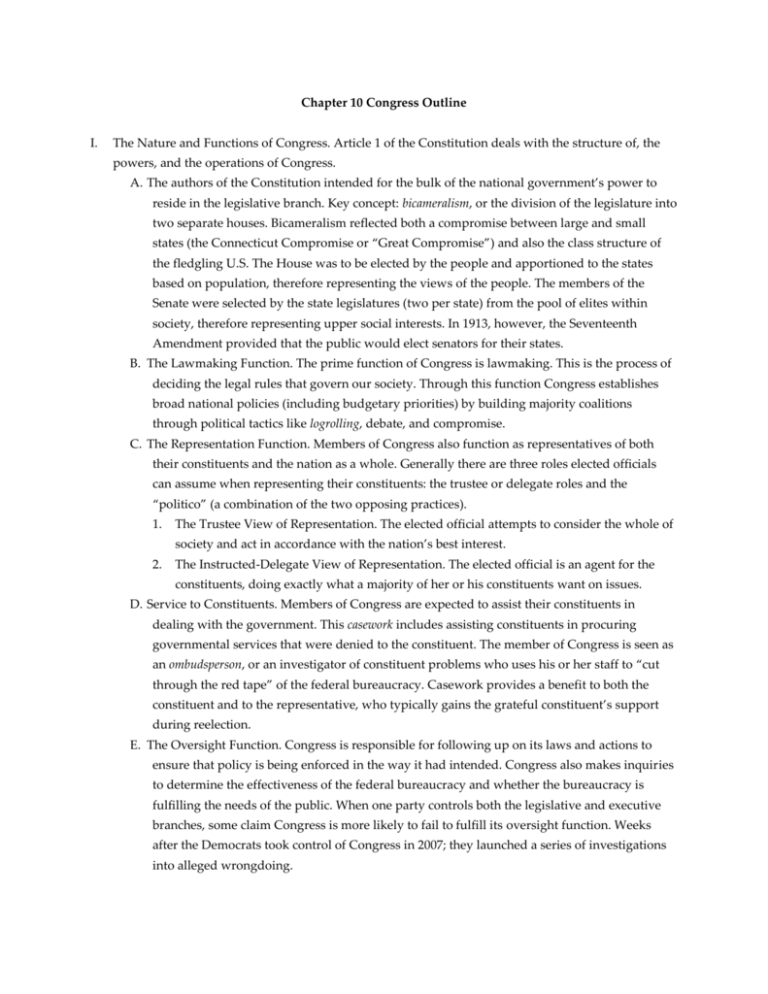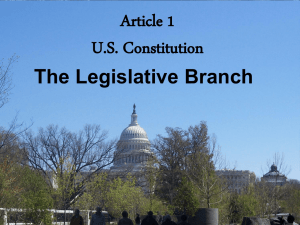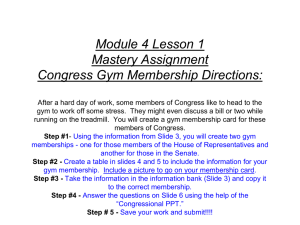Chapter 10 Congress Outline The Nature and Functions of
advertisement

Chapter 10 Congress Outline I. The Nature and Functions of Congress. Article 1 of the Constitution deals with the structure of, the powers, and the operations of Congress. A. The authors of the Constitution intended for the bulk of the national government’s power to reside in the legislative branch. Key concept: bicameralism, or the division of the legislature into two separate houses. Bicameralism reflected both a compromise between large and small states (the Connecticut Compromise or “Great Compromise”) and also the class structure of the fledgling U.S. The House was to be elected by the people and apportioned to the states based on population, therefore representing the views of the people. The members of the Senate were selected by the state legislatures (two per state) from the pool of elites within society, therefore representing upper social interests. In 1913, however, the Seventeenth Amendment provided that the public would elect senators for their states. B. The Lawmaking Function. The prime function of Congress is lawmaking. This is the process of deciding the legal rules that govern our society. Through this function Congress establishes broad national policies (including budgetary priorities) by building majority coalitions through political tactics like logrolling, debate, and compromise. C. The Representation Function. Members of Congress also function as representatives of both their constituents and the nation as a whole. Generally there are three roles elected officials can assume when representing their constituents: the trustee or delegate roles and the “politico” (a combination of the two opposing practices). 1. The Trustee View of Representation. The elected official attempts to consider the whole of society and act in accordance with the nation’s best interest. 2. The Instructed-Delegate View of Representation. The elected official is an agent for the constituents, doing exactly what a majority of her or his constituents want on issues. D. Service to Constituents. Members of Congress are expected to assist their constituents in dealing with the government. This casework includes assisting constituents in procuring governmental services that were denied to the constituent. The member of Congress is seen as an ombudsperson, or an investigator of constituent problems who uses his or her staff to “cut through the red tape” of the federal bureaucracy. Casework provides a benefit to both the constituent and to the representative, who typically gains the grateful constituent’s support during reelection. E. The Oversight Function. Congress is responsible for following up on its laws and actions to ensure that policy is being enforced in the way it had intended. Congress also makes inquiries to determine the effectiveness of the federal bureaucracy and whether the bureaucracy is fulfilling the needs of the public. When one party controls both the legislative and executive branches, some claim Congress is more likely to fail to fulfill its oversight function. Weeks after the Democrats took control of Congress in 2007; they launched a series of investigations into alleged wrongdoing. F. The Public-Education Function. Congress presents a range of viewpoints on national questions when it holds public hearings, exercises oversight, and engages in debate on major issues. Congress also sets the agenda when it decides what issues come up for debate and consideration. G. The Conflict-Resolution Function. Congress acts as an institution to resolve conflicts within American society, brokering between opposing viewpoints or resource demands. II. The Powers of Congress A. Enumerated Powers. The enumerated powers are set forth in Article I, Section 8. Enumerated powers, or expressed powers, are specific grants of power to Congress. These powers include taxing, spending, borrowing, and coining; regulation of foreign trade and trade among states; regulation of the military (state militias, the army and navy, and the power to declare war); as well as the power to define the court structure. 1. Powers of the Senate. The Senate must “advise and consent” to treaties and the appointment of top officials like Supreme Court justices. 2. Constitutional Amendments. Congress has received other grants of power through amendments (such as the Sixteenth Amendment that allows Congress to levy an income tax). B. The Necessary and Proper Clause. The necessary and proper, or “elastic,” clause of Article I, Section 8 allows Congress to make laws that are deemed necessary to carry out the enumerated powers. Recall the discussion of Chapter 3: the loose wording of this clause has, over time, allowed Congress (and therefore the national government) to expand its powers greatly. III. House-Senate Differences Congress is composed of two chambers: the lower chamber, the House of Representatives; and the upper chamber, the Senate. There are major differences between the two chambers. See Table 10-1. A. Size and Rules. The most noticeable difference between the two houses is size: the House has 435 members while the senate has 100. Because of the large number of members in the House there are many formal rules to govern floor debate, determined and regulated by the Rules Committee. Since there are considerably fewer members in the Senate, there are fewer restrictions on floor activity. B. Debate and Filibustering. The Senate’s tradition of unlimited debate can lead to the use of such debate to block a bill in a filibuster. Cloture is a way to stop the filibuster, requiring the approval of 60 senators. If a vote for cloture is approved, debate is limited to a maximum of one hour per senator. C. Prestige. The houses also differ in prestige. Senators, because of their longer term and smaller number, can achieve a level of personal recognition that is almost impossible to achieve in the larger House of Representatives unless one holds a leadership position. IV. Congresspersons and the Citizenry: A Comparison In comparison to the general population, the members of Congress are significantly different both demographically and economically. The members of Congress are older, wealthier, and better educated than the general public (with a disproportionate number of lawyers holding congressional seats). There are relatively few women and members of minority groups in Congress, although this situation is improving. See Table 10-2. V. Congressional Elections State governments conduct their individual elections for members of Congress. Representatives are elected every two years; each state has at least one representative, with the number of seats per state awarded every decade by the results of the census. Senators serve six-year terms, and only about one-third of the Senate is up for reelection every two years. Only states can elect members of Congress, but territories and the District of Columbia send nonvoting delegates to Congress. A. Candidates for Congressional Elections. Candidates for congressional seats can be self-selected or recruited by the local political party. Usually the party attempts to select a candidate who possesses many of the social characteristics of the population in the district. It is also likely that a person will be picked who has been successful in elections at the local or state level. 1. Congressional Campaigns and Elections. The importance of fundraising has increased in the past twenty years. Victorious candidates for the Senate have recently spent an average of over $7 million, while successful House candidates have averaged just over a million dollars. In every state nominations for Congress are determined by the voters in a direct primary election. In this election candidates vie for the nomination among voters who are party identifiers. If a candidate wins the nomination, she or he will go on to run under the party label in the general election. 2. Presidential Effects. If a strong presidential candidate is on the ticket, that candidate may have “coattails” that benefit congressional candidates of the president’s party. However, the presidential coattail effect in recent years has been modest or nonexistent; in fact, a reverse coattail effect has been observed in mid-term elections. B. The Power of Incumbency. Incumbents have a huge advantage in congressional elections. See Table 10-4 for the dramatic reelection rates of House and Senate members (over 90 percent for the former over the last 20 years). One of the major reasons for the overwhelming incumbency advantage is the free publicity the member of Congress receives. The media constantly reports on events that involve the members of Congress. The public usually knows much more about members of Congress than they do about challengers. Incumbents are able to run based on their record of casework and obtaining federal money and projects for their constituents. Incumbents also have the advantage when it comes to fundraising. C. Party Control of Congress after the 2006 Elections. The 2006 mid-term elections represented the reverse coattail effect, as President George W. Bush’s Republican Party lost control of both the House and the Senate. Democratic leaders in both chambers have reached across the aisle to enlist Republican support, which is particularly necessary in the Senate where Democrats have a narrow majority. VI. Congressional Apportionment Key concepts: reapportionment—the allocation of seats in the House of Representatives to each state after each census, and redistricting—the redrawing of the boundaries of the congressional districts within each state. Historically, House districts within states often had wildly disproportionate populations, usually to the benefit of rural areas. The same was true of districts established to elect state legislators. In 1962, the Supreme Court ruled that legislative districts for the lower houses in state legislatures had to be of equal population (thus also ruling the question of apportionment to be justiciable). In 1964, it extended that logic to state senates and to the U.S. House. A. Gerrymandering. A second problem with drawing district lines is gerrymandering, the practice of drawing lines to favor one party over the other. The Supreme Court has ruled that, in principle, partisan gerrymandering in the extreme might violate voters’ constitutional rights, but it has yet to find a single instance of partisan gerrymandering unconstitutional. B. Redistricting After the 2000 Census. Gerrymandering by the party in control of a state legislature is almost universal today; it became much more efficient when computers were applied to the task. Two techniques of partisan redistricting are “packing” the other party’s supporters into the fewest number of districts to ensure that many of their votes will be wasted and “cracking” the supporters of the other party among the remaining districts in numbers too small to affect an election. The Supreme Court’s unwillingness to strike down obviously gerrymandered districts in Pennsylvania and Texas demonstrate with clarity that the Court will not take up issues of purely political gerrymandering. One result is that only a small percentage of House seats typically are open for any real competition. C. “Minority-Majority” Districts. In the 1990s, in an effort to combat the effects of past discrimination, the federal government encouraged the creation of districts with enough minority group members to elect a minority group member to Congress. These were called “minority-majority” districts. 1. Constitutional Challenges. The Supreme Court, however, has held that states cannot construct districts on the basis of race alone. In 1995 it rejected a plan for a Georgia district on this basis. 2. Changing Directions. In recent cases, the Court has been willing to accept redistricting plans in areas that formerly practiced legal discrimination (in this case, Louisiana) unless the plan left minorities worse off than before. VII. Perks and Privileges An example of congressional privilege is franking, the use of a signature instead of a postage stamp; there are many other benefits, however. A. Permanent Professional Staffs. Members of Congress have large staffs; the average office employs about 30 staff members. Congress also benefits from the resources and expertise of agencies created to assist members, such as the Government Accountability Office (formerly the General Accounting Office). B. Privileges and Immunities under the Law. Representatives and Senators cannot be sued for slander for anything they say in Congress. C. Congressional Caucuses: Another Source of Support. The key caucuses are the official caucuses of the two major parties. There are over 200 other caucuses, ranging from important bodies (the Congressional Black Caucus) to the less important (the Potato Caucus). VIII. The Committee Structure A. The Power of Committees. The key to understanding how Congress gets things done is to understand congressional committees. These “little legislatures” have the final say on a piece of legislation. They are only rarely deprived of control of a bill they’ve shepherded through the system, though the system to do so—the discharge petition—exists. B. Types of Congressional Committees. 1. Standing Committees. These are the most important committees in Congress because all bills are referred to a standing committee in each chamber. Each standing committee covers an area of specialization and is subdivided into subcommittees. 2. Select Committees. These are created to accomplish a particular task. Unlike standing committees, select committees are not permanent. Once the task has been accomplished, the select committee may be abolished. Some select committees live forever, though, such as the Select Committee on Intelligence in each chamber. 3. Joint Committees. These are established with members of each chamber serving on the committee. The tasks assigned to these committees are very diverse. 4. Conference Committees. These are special joint committees convened when a bill has passed both chambers but there are differences between the version approved by the House and the version approved by the Senate. The role of the conference committee is to reach a compromise between the different versions. After the compromise is reached, both houses must approve of the compromise bill before it is sent to the president. 5. House Rules Committee. This is a very powerful standing committee in the House of Representatives. Once the appropriate standing committee in the House has approved a bill, it is sent to the Rules Committee. This committee makes rules that will govern what happens to the bill on the floor of the House. C. The Selection of Committee Members. The political parties conduct the selection of committee members through party Steering Committees. Once assigned to a committee, the member is likely to remain on the committee for the remainder of her or his career in that chamber. In general the most senior member of the majority party will be selected as the chairperson of the committee. Such a seniority system rewards those who are from districts with safe seat and who can therefore be reelected numerous times. This is an informal system only, and both Democrats and Republicans have veered from it. IX. The Formal Leadership The majority party controls the legislative process, including the selection of congressional leaders. A. Leadership in the House. 1. The Speaker. The Speaker of the House of Representatives is the most powerful member of the House. In general, the Speaker’s powers are related to his or her control over the flow of information in the House. The Speaker: presides over meetings of the House, appoints members of joint committees and conference committees, schedules legislation for floor action, decides points of order and interprets the rules with the advice of the House parliamentarian, and refers bills and resolutions to the appropriate standing committees of the House. 2. The Majority Leader. This person is second in line in the majority party leadership structure. He or she is responsible for assisting the Speaker in gaining the enactment of the majority party’s legislation. The majority leader fosters cohesion among party members in the House. 3. The Minority Leader. This person is the leader of the minority party in the House. His or her primary responsibility is to seek the enactment of his party’s legislative proposals, and to provide a source of “loyal opposition” to the majority party. If the president is a member of the minority party, the minority leader speaks on his or her behalf in the House. 4. Whips. Both the majority and minority parties have whips whose job is to assist their party leaders and to encourage party loyalty among House members. B. Leadership in the Senate. The president of the Senate is the vice president of the United States, but the vice president rarely actually presides over the Senate. On rare occasions, the vice president will be called upon to vote in the Senate to break a tie. The president pro tempore (usually referred to as the pro tem) is the mostly ceremonial presiding officer of the Senate, usually the member of the majority with the longest continuous term of service in the Senate. The majority leader is the most powerful member of the Senate, who directs the legislative program. The minority leader represents and directs the minority party in the Senate. As in the House, both the majority and minority parties have whips whose job is to assist their party leaders and to encourage party loyalty among Senate members. X. How Members of Congress Decide Party membership is a major determinant of how members vote, but it is not the only factor at work. A. The Conservative Coalition. In the 1950s and 1960s, a coalition between conservative (largely southern) Democrats and Republicans often had a majority of the votes and could set policy. Today, however, there are not many of these conservative Democrats left and the conservative coalition has been relegated to history. B. “Crossing Over.” Members are especially likely to vote with the other party in cases where their own party has adopted positions that conflict with the interests of the member’s district. Members may also have positions on cultural issues such as abortion that are different from the majority position of their party. XI. How a Bill Becomes a Law For a bill to become law, it must pass through both houses of Congress. All “money bills” or spending measures must originate in the House. A bill can be introduced in either the House or the Senate in similar fashion. A member (or members) drafts a bill and submits it to the presiding officer. After the bill has been introduced, it will be referred to the standing committee that has jurisdiction over the subject matter of the bill. In the House, the next step is the Rules Committee, which schedules it for House debate; in the Senate, this action is done by the Senate leadership. Then the bill and all proposed amendments are debated and the bill is put to a vote. If a majority of those voting are in favor of the bill, it is passed. If there are differences between the House version of the bill and the Senate version of the bill, the bill will be sent to a conference committee. If the members are able to work out a compromise, the bill is sent back to the floor of each chamber for re-approval. After approval, the bill is sent to the president, who may either sign or veto the bill. See Figure 10-3 for a graphic depiction of this process. XII. How Much Will the Government Spend? The Budget Impoundment and Control Act of 1974 required the president to spend the money that Congress has appropriated and attempted to make Congress examine total national taxing and spending. See Figure 10-4 for a graphic depiction of the budget process. A. Preparing the Budget. Preparing the budget begins eighteen months before the start of the fiscal year. The federal fiscal year, used for accounting, begins on October 1 and ends September 30. The Office of Management and Budget (OMB) conducts a spring review and a fall review of spending. The fall review—conducted a year before the relevant fiscal year begins—is the important review. At this time, the OMB cuts back executive agency budget requests and begins preparing the executive budget. The president submits an extremely detailed executive budget to Congress in January. This budget attempts to estimate all the revenue the government will generate (through taxes, fees, duties, etc.) and all of the expenditures of the federal government. B. Congress Faces the Budget. Congress then takes over. Key concepts: authorization and appropriation. Authorization is a formal declaration by a legislative committee that a certain amount of funding may be available to an agency. Some authorizations terminate in a year; others are renewable automatically without further congressional action. Appropriation is the passage by Congress of a spending bill specifying the amount of authorized funds that actually will be allocated for an agency’s use. In 1998, President Clinton and the Republican Congress passed the first balanced budget in decades, but subsequent budgets in the George W. Bush administration have not been balanced. C. Budget Resolutions. The Congress is supposed to pass the first budget resolution in May. This resolution sets overall revenue and spending goals, thus determining the size of the deficit or surplus for the next fiscal year. In September, Congress is scheduled to pass the second budget resolution. This resolution sets binding limits on taxes and spending for the fiscal year beginning October 1. Frequently, Congress does not make the October 1 deadline. It must then pass a continuing resolution, a temporary measure that allows government agencies to continue operating with the same funding as last year. XIII. Features A. What if …… Pork Were Banned? The idea behind pork-barrel legislation is that a congressperson can obtain funding for constituents’ favorite projects, a process also known as “earmarking.” The practice has grown dramatically, from about 120 in 1987 to about 1,200 ten years ago to close to 14,000 in 2006. Opponents of pork barrel spending have said that it does not have a long history in the U.S. and that it is “the root cause of the unholy relationship between some members of Congress, lobbyists, and donors.” Supporters of the process say that members of Congress are best positioned to know what is good for their districts and that debating each of the projects individually would cause the legislative process to grind to a halt. The reality is that such programs represent only one percent of the federal budget. B. Politics and the Cybersphere. Members of Congress resist the Online World. Because e-mail has become more prevalent and congressional staffers haven’t been able to keep up with the communication, some staffers simply turn off their members’ public e-mail addresses. C. Elections 2008. Party Control of Congress after the 2008 Elections. D. Which Side Are You On? Should Free Congressional Mailings Be Eliminated? Franking is the formal word for sending mail postage-free. The law allows members of Congress to simply sign their names in the upper right hand corner of letters and packages instead of using postage. The reason members receive these privileges is to keep constituents informed about congressional matters but it is more often used for political reasons. E. Politics and Congress. A Full Week’s Work? The vast majority of the 109 th Congress were members of the three-day-a-week club. Most congresspersons did not come to their office until early Tuesday morning then returned to their home states on Thursday night after the last vote was taken. The number of days the 109 th was in session dropped to 250, down from more than 320 in the 1960s and 1970s. Much of the work was conducted by a small group of leadership staff, committee staff, industry representatives, and a few important party members. F. Why Should You Care About Congress? The legislation Congress passes can affect your daily life. There is much more useful information to learn about your representatives than just their names and parties. You can contact members of Congress by going to Web sites and by email. Many interest groups, though, argue that the U.S. mail is more likely to capture the attention of representatives than e-mail. Interest groups also track the voting records of congresspersons.









